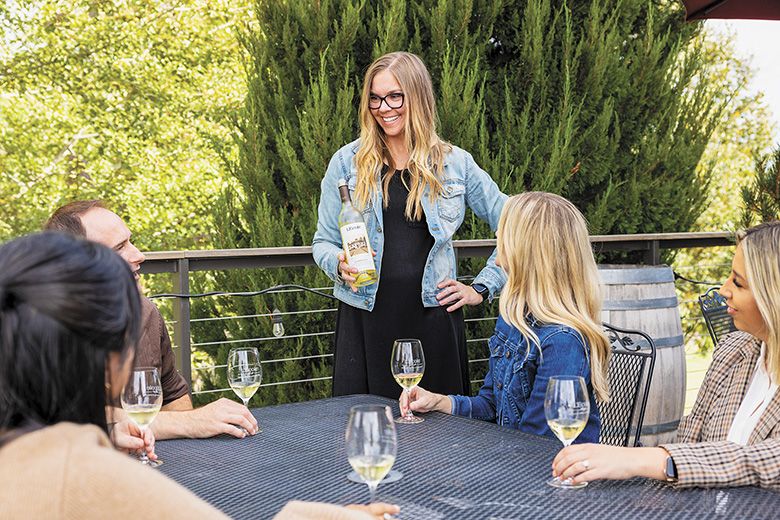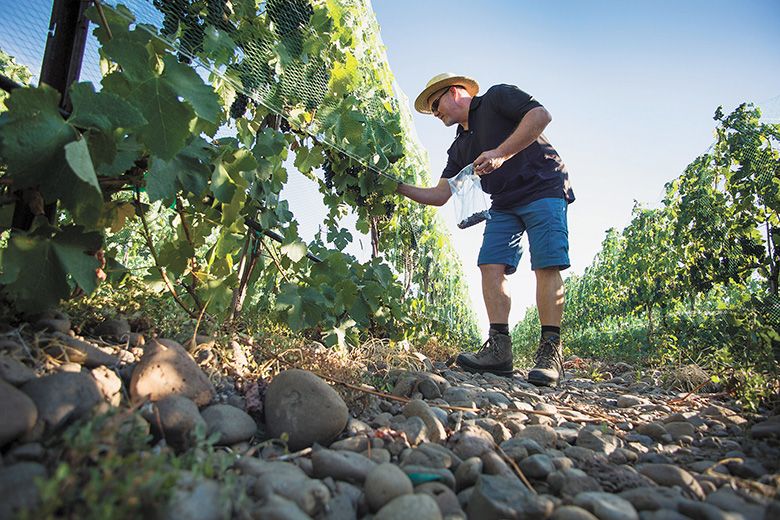Do-Si-Do
Winery association partnerships dance together


By Jessica Zimmer
For over two decades, Oregon and Washington wineries have worked together to demonstrate their thoughtful approach to cultivation and winemaking. The result? The Pacific Northwest is well known for its premier wines. This is due, in part, to Oregon winery associations regularly communicating with “sister” counterparts in Washington.
This year, the Willamette Valley Wineries Association and Walla Walla Valley Wine will jointly host a series of press visits highlighting both river valleys. Their goal? To show how the Valleys complement each another.
“We want to tell stories that raise interest in both the Willamette and the Walla Walla Valleys. We hope to share the beauty and history to attract domestic and international visitors,” said Morgen McLaughlin, executive director of the Willamette Valley Wineries Association and the Willamette Valley Wine Foundation.
Attracting visitors to the regions is a vital part of promotion. Enjoying hikes and scenic drives helps illustrate the distinct geology of the Columbia River, which flows through both states. Both the Willamette and Walla Walla Rivers are tributaries feeding into the Columbia. The base of the Columbia’s basalt floodplain consists of multiple ancient lava flows. Soils in the Columbia River Basin drain well while retaining heat. They also contain elevated amounts of iron, the mineral imparting a meaty taste in wines like Grenache.
“We are creating itineraries that will introduce wine travelers to wines in both regions. This will go beyond identifying specific Willamette Valley wineries making high-scoring Pinot Noir and Chardonnay and Washington wineries crafting excellent Syrah and Cabernet Sauvignon. We will feature wineries producing lesser-known varieties like Gamay and Grüner Veltliner,” said McLaughlin.
Both associations will include information on organic farming methods and spotlight places to stay, dine and drink.
“The Willamette and Walla Walla associations plan to share information about microclimates in the two Valleys,” said Liz Knapke, executive director of Walla Walla Valley Wine and the Walla Walla Valley Wine Alliance. She continued, “We have over 135 wineries in the Walla Walla Valley. We want visitors to know all the must-see wine destinations in the Northwest.”
Because the designated Walla Walla Valley appellation spans two states, the organization has a strong interest in promoting wineries in Oregon and Washington. “The association is based in Washington and we hold tasting events like “Walla Walla Wine on Tour” in Portland, Seattle and Boise. Around here, we say, ‘Great wines cross state lines,’” noted Knapke.
Relations were not always cordial
In the 1990s, Oregon and Washington wine industries did not collaborate marketing efforts. Wineries in the two states viewed each other as distinctive wine regions– even competitors. “The turning point came around 2004,” said Martin Clubb, owner and managing winemaker of L’Ecole No 41 in Lowden, Washington.
“At that time, wineries from Oregon and Washington began promoting their wines at international trade fairs in London and other cities in Europe. More recently they’ve collaborated at the ProWine Trade Fair in Düsseldorf, Germany. With this success, they expanded to events like Vinexpo Asia and city-specific shows in Hong Kong, Japan and South Korea,” said Clubb.
The partnership works successfully because the two states produce complementary wine styles.
“Oregon is cooler, so it excels with varietals such as Pinot Noir and Pinot Gris. Washington’s wine-growing region is warmer, great for Bordeaux and Rhône Valley varieties like Cabernet Sauvignon and Syrah,” said Clubb.
Winemakers tend to travel between the regions with business contacts in both states, yet another reason it makes sense for wineries to work together.
“More people from Oregon and Washington in an expo hall increases the chance of giving the Pacific Northwest higher visibility. Yet there are some differences. Oregon wineries are small to mid-size; Washington wineries range from small to large. Also, Oregon leads the way in sustainable agriculture,” said Clubb.
LIVE, a Portland-based nonprofit that grants third-party certification in sustainable viticulture to wineries in Oregon, Washington and Idaho, played a significant role in increasing green practices.
On a national scale, Oregon and Washington are currently promoting wines together in Canada and other countries through the Northwest Wine Promotion Coalition, a campaign created by the U.S. Department of Agriculture, or USDA. Its goal includes increasing Northwest wine exports to targeted markets abroad.
In fiscal year 2023, the USDA’s Foreign Agricultural Service, a federal agency that helps U.S. agricultural producers enter global markets, invested more than $8.6 million in wine promotion through its Market Access program. Over $1.2 million of this funding targeted the Northwest Wine Promotion Coalition, according to Zechariah Henderson, director of the high-value products branch with the USDA Foreign Agricultural Service.
There are small-scale cooperative efforts underway as well.
Richard Funk, owner and winemaker at Saviah Cellars in Walla Walla, also owns Funk Estate Vineyard, situated in Oregon’s The Rocks District of the Milton-Freewater appellation. “For the last decade, I’ve sold fruit from my vineyard to several Oregon wineries, including Big Table Farm in Gaston and Watermill Winery in Milton-Freewater. I love how they have expressed and respected the terroir. My goal is to help showcase the superstar varietals, like Syrah from The Rocks District. These can compete with the finest Rhônes from France,” said Funk.
Respecting place is critical
Winemakers focusing on one varietal in a particular area also support Oregon and Washington wineries working together.
Seth Morgen Long, a winemaker based in the Willamette Valley, crafts Willamette Valley Chardonnay exclusively. His wines reflect grape, time and place, with notes of flint, citrus oil, ginger and mint. “I believe efforts like mine encourage thoughtful stewardship of rural places and help grow better grapes. Reverence for place helps me make better wines,” said Long.
Winegrowers and winemakers demonstrating a serious commitment often receive higher scores and wider recognition. This leads to an increased awareness that grape and wine quality cannot easily be replicated in other locations.
In the next few years, Oregon and Washington associations will develop more of a common culture and vibe. McLaughlin said there is already discussion of cross-border collaborations involving other Oregon wine regions, including the Rogue and Umpqua valleys.
“The COVID-19 pandemic has been extremely disruptive to tourism, including wine travel. It only makes sense to increase connections and give guests more reasons to taste Oregon wines,” said McLaughlin.
Jessica Zimmer is a news reporter, attorney, and educator based in northern California. She has worked in journalism for over 20 years. She covers a wide variety of industries, including alcoholic beverage production, transportation, law and the arts.








